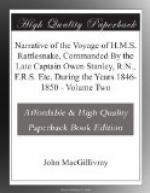CONTENTS OF PLATES OF NEW SHELLS.
Tab. 2.
Fig. 1. Helix brumeriensis.
Fig. 2. Helix franklandiensis.
Fig. 3. Helix inconspicua.
Fig. 4. Helix iuloides.
Fig. 5. Helix divisa.
Fig. 6. Helix yulei.
Fig. 7. Helix dunkiensis.
Fig. 8. Helix louisiadensis.
Fig. 9. Balea australis.
Fig. 10. Pupina grandis.
Tab. 3.
Fig. 1. Helix macgillivrayi.
Fig. 2. Pupina Thomsoni.
Fig. 3. Helicina gouldiana.
Fig. 4. Helicina stanleyi.
Fig. 5. Helicina louisiadensis.
Fig. 6. Ranella pulchra.
Fig. 7. Scalaria jukesiana.
Fig. 8. Macgillivrayia pelagica.
Fig. 9. Cheletropis huxleyi.
...
APPENDIX 6.
DESCRIPTIONS OF SOME NEW SPECIES OF ANNULOSA COLLECTED BY MR. MACGILLIVRAY DURING THE VOYAGE OF H.M.S. RATTLESNAKE, BY ADAM WHITE, ESQUIRE, F.L.S., ASSISTANT ZOOLOGICAL DEPARTMENT, BRITISH MUSEUM.
Among the very numerous Insects and Crustacea, collected by Mr. Macgillivray during the voyage of the Rattlesnake, the following have been selected for illustration; references to and descriptions of some of the Diptera, Homoptera, and Hemiptera, collected by him, have appeared in the Catalogues of the British Museum drawn up hy Messrs. Walker and Dallas, while the names and descriptions of others will appear in catalogues in preparation. A fine species of the class Crustacea, discovered by him, has been described and figured in the Illustrated Proceedings of the Zoological Society. (Cancer [Galene] dorsalis, White.)
INSECTS. COLEOPTERA.
Chrysodema pistor, Laporte and Gory. Buprestidae, t. 6, f. 33.
Habitat: Australia (Cape Upstart). Mr. Macgillivray informs me, that the specimens of this species were observed by him coming out of a dead tree (Casuarina).
Pachyrhynchus stanleyanus.* Tab. 4 fig. 1, 2.
(Footnote. In memoriam Owen Stanley, in classe Britannica Navarchi, species haec distincta et peculiaris nominatur.)




